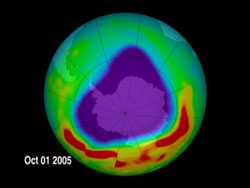NASA Study Finds Clock Ticking Slower On Ozone Hole Recovery

This still image is from an animation that zooms down to Antarctica and shows the daily ozone readings from July 1, 2005 to October 25,2005. Credit: NASA
Scientists from NASA, the National Oceanic and Atmospheric Administration and the National Center for Atmospheric Research in Boulder, Colo., have developed a new tool, a math-based computer model, to better predict when the ozone hole will recover.
The Antarctic ozone hole is a massive loss of ozone high in the atmosphere (the stratosphere) that occurs each spring in the Southern Hemisphere. The ozone hole is caused by chlorine and bromine gases in the stratosphere that destroy ozone. These gases come from human-produced chemicals such as chlorofluorocarbons, otherwise called CFCs.
The ozone layer blocks 90-99 percent of the sun's ultraviolet radiation from making contact with Earth. That harmful radiation can cause skin cancer, genetic damage, and eye damage, and harm marine life.
For the first time, a model combines estimates of future Antarctic chlorine and bromine levels based on current amounts as captured from NASA satellite observations, NOAA ground-level observations, NCAR airplane-based observations, with likely future emissions, the time it takes for the transport of those emissions into the Antarctic stratosphere, and assessments of future weather patterns over Antarctica.
The model accurately reproduces the ozone hole area in the Antarctic stratosphere over the past 27 years. Using the model, the researchers predict that the ozone hole will recover in 2068, not in 2050 as currently believed.
“The Antarctic ozone hole is the poster child of ozone loss in our atmosphere,” said author Paul Newman, a research scientist at NASA's Goddard Space Flight Center, Greenbelt, Md. And lead author of the study. “Over areas that are farther from the poles like Africa or the U.S., the levels of ozone are only three to six percent below natural levels. Over Antarctica, ozone levels are 70 percent lower in the spring. This new method allows us to more accurately estimate ozone-depleting gases over Antarctica, and how they will decrease over time, reducing the ozone hole area.”
International agreements like the Montreal Protocol have banned the production of most chemicals that destroy ozone. But the researchers show that the ozone hole has not started to shrink a lot as a result. The scientists predict the ozone hole will not start shrinking a lot until 2018. By that year, the ozone hole's recovery will make better time.
Media Contact
More Information:
http://www.nasa.govAll latest news from the category: Earth Sciences
Earth Sciences (also referred to as Geosciences), which deals with basic issues surrounding our planet, plays a vital role in the area of energy and raw materials supply.
Earth Sciences comprises subjects such as geology, geography, geological informatics, paleontology, mineralogy, petrography, crystallography, geophysics, geodesy, glaciology, cartography, photogrammetry, meteorology and seismology, early-warning systems, earthquake research and polar research.
Newest articles

Bringing bio-inspired robots to life
Nebraska researcher Eric Markvicka gets NSF CAREER Award to pursue manufacture of novel materials for soft robotics and stretchable electronics. Engineers are increasingly eager to develop robots that mimic the…

Bella moths use poison to attract mates
Scientists are closer to finding out how. Pyrrolizidine alkaloids are as bitter and toxic as they are hard to pronounce. They’re produced by several different types of plants and are…

AI tool creates ‘synthetic’ images of cells
…for enhanced microscopy analysis. Observing individual cells through microscopes can reveal a range of important cell biological phenomena that frequently play a role in human diseases, but the process of…





















